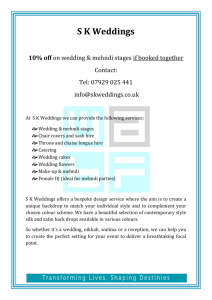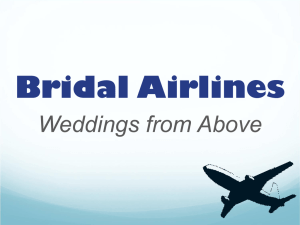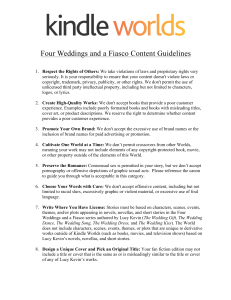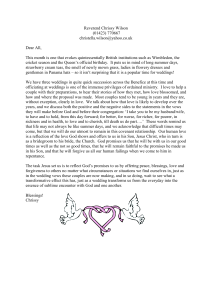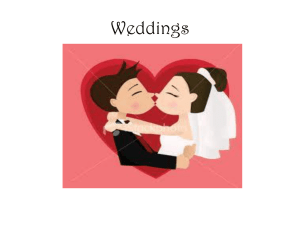LeonardSpr2013
advertisement
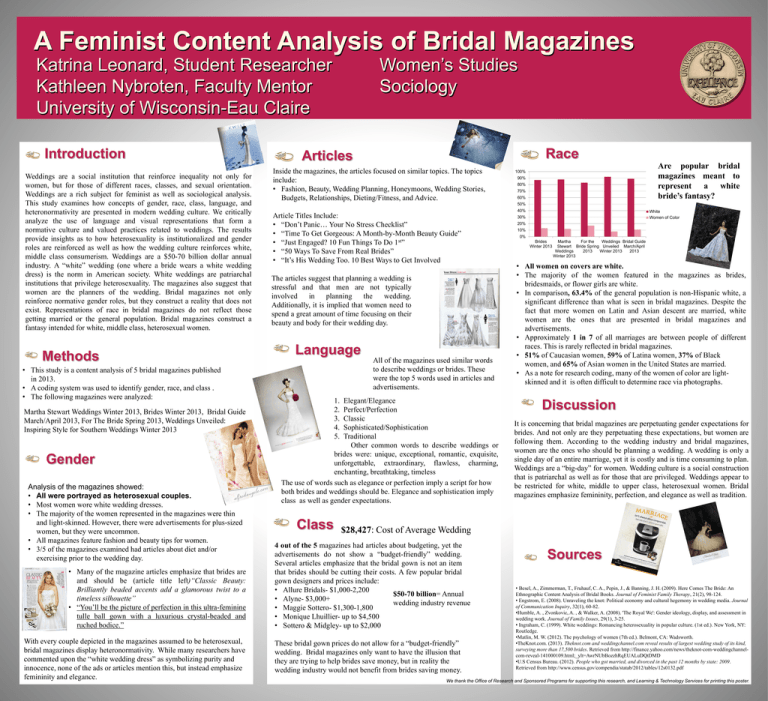
A Feminist Content Analysis of Bridal Magazines Women’s Studies Sociology Katrina Leonard, Student Researcher Kathleen Nybroten, Faculty Mentor University of Wisconsin-Eau Claire iIntroduction Weddings are a social institution that reinforce inequality not only for women, but for those of different races, classes, and sexual orientation. Weddings are a rich subject for feminist as well as sociological analysis. This study examines how concepts of gender, race, class, language, and heteronormativity are presented in modern wedding culture. We critically analyze the use of language and visual representations that form a normative culture and valued practices related to weddings. The results provide insights as to how heterosexuality is institutionalized and gender roles are reinforced as well as how the wedding culture reinforces white, middle class consumerism. Weddings are a $50-70 billion dollar annual industry. A “white” wedding (one where a bride wears a white wedding dress) is the norm in American society. White weddings are patriarchal institutions that privilege heterosexuality. The magazines also suggest that women are the planners of the wedding. Bridal magazines not only reinforce normative gender roles, but they construct a reality that does not exist. Representations of race in bridal magazines do not reflect those getting married or the general population. Bridal magazines construct a fantasy intended for white, middle class, heterosexual women. Methods • This study is a content analysis of 5 bridal magazines published in 2013. • A coding system was used to identify gender, race, and class . • The following magazines were analyzed: Martha Stewart Weddings Winter 2013, Brides Winter 2013, Bridal Guide March/April 2013, For The Bride Spring 2013, Weddings Unveiled: Inspiring Style for Southern Weddings Winter 2013 Gender Analysis of the magazines showed: • All were portrayed as heterosexual couples. • Most women wore white wedding dresses. • The majority of the women represented in the magazines were thin and light-skinned. However, there were advertisements for plus-sized women, but they were uncommon. • All magazines feature fashion and beauty tips for women. • 3/5 of the magazines examined had articles about diet and/or exercising prior to the wedding day. • Many of the magazine articles emphasize that brides are and should be (article title left)“Classic Beauty: Brilliantly beaded accents add a glamorous twist to a timeless silhouette” • “You’ll be the picture of perfection in this ultra-feminine tulle ball gown with a luxurious crystal-beaded and ruched bodice.” With every couple depicted in the magazines assumed to be heterosexual, bridal magazines display heteronormativity. While many researchers have commented upon the “white wedding dress” as symbolizing purity and innocence, none of the ads or articles mention this, but instead emphasize femininity and elegance. Race Articles Inside the magazines, the articles focused on similar topics. The topics include: • Fashion, Beauty, Wedding Planning, Honeymoons, Wedding Stories, Budgets, Relationships, Dieting/Fitness, and Advice. Are popular bridal magazines meant to represent a white bride’s fantasy? 100% 90% 80% 70% 60% 50% 40% Article Titles Include: • “Don’t Panic… Your No Stress Checklist” • “Time To Get Gorgeous: A Month-by-Month Beauty Guide” • “Just Engaged? 10 Fun Things To Do 1st” • “50 Ways To Save From Real Brides” • “It’s His Wedding Too. 10 Best Ways to Get Involved The articles suggest that planning a wedding is stressful and that men are not typically involved in planning the wedding. Additionally, it is implied that women need to spend a great amount of time focusing on their beauty and body for their wedding day. Language All of the magazines used similar words to describe weddings or brides. These were the top 5 words used in articles and advertisements. 1. 2. 3. 4. 5. Elegant/Elegance Perfect/Perfection Classic Sophisticated/Sophistication Traditional Other common words to describe weddings or brides were: unique, exceptional, romantic, exquisite, unforgettable, extraordinary, flawless, charming, enchanting, breathtaking, timeless The use of words such as elegance or perfection imply a script for how both brides and weddings should be. Elegance and sophistication imply class as well as gender expectations. Class White Women of Color 30% 20% 10% 0% Brides Winter 2013 Martha For the Weddings Bridal Guide Stewart Bride Spring Unveiled March/April Weddings 2013 Winter 2013 2013 Winter 2013 • All women on covers are white. • The majority of the women featured in the magazines as brides, bridesmaids, or flower girls are white. • In comparison, 63.4% of the general population is non-Hispanic white, a significant difference than what is seen in bridal magazines. Despite the fact that more women on Latin and Asian descent are married, white women are the ones that are presented in bridal magazines and advertisements. • Approximately 1 in 7 of all marriages are between people of different races. This is rarely reflected in bridal magazines. • 51% of Caucasian women, 59% of Latina women, 37% of Black women, and 65% of Asian women in the United States are married. • As a note for research coding, many of the women of color are lightskinned and it is often difficult to determine race via photographs. Discussion It is concerning that bridal magazines are perpetuating gender expectations for brides. And not only are they perpetuating these expectations, but women are following them. According to the wedding industry and bridal magazines, women are the ones who should be planning a wedding. A wedding is only a single day of an entire marriage, yet it is costly and is time consuming to plan. Weddings are a “big-day” for women. Wedding culture is a social construction that is patriarchal as well as for those that are privileged. Weddings appear to be restricted for white, middle to upper class, heterosexual women. Bridal magazines emphasize femininity, perfection, and elegance as well as tradition. $28,427: Cost of Average Wedding 4 out of the 5 magazines had articles about budgeting, yet the advertisements do not show a “budget-friendly” wedding. Several articles emphasize that the bridal gown is not an item that brides should be cutting their costs. A few popular bridal gown designers and prices include: • Allure Bridals- $1,000-2,200 $50-70 billion= Annual • Alyne- $3,000+ wedding industry revenue • Maggie Sottero- $1,300-1,800 • Monique Lhuillier- up to $4,500 • Sottero & Midgley- up to $2,000 These bridal gown prices do not allow for a “budget-friendly” wedding. Bridal magazines only want to have the illusion that they are trying to help brides save money, but in reality the wedding industry would not benefit from brides saving money. Sources • Besel, A., Zimmerman, T., Fruhauf, C. A., Pepin, J., & Banning, J. H. (2009). Here Comes The Bride: An Ethnographic Content Analysis of Bridal Books. Journal of Feminist Family Therapy, 21(2), 98-124. • Engstrom, E. (2008). Unraveling the knot: Political economy and cultural hegemony in wedding media. Journal of Communication Inquiry, 32(1), 60-82. •Humble, A. , Zvonkovic, A. , & Walker, A. (2008). 'The Royal We': Gender ideology, display, and assessment in wedding work. Journal of Family Issues, 29(1), 3-25. • Ingraham, C. (1999). White weddings: Romancing heterosexuality in popular culture. (1st ed.). New York, NY: Routledge. •Matlin, M. W. (2012). The psychology of women (7th ed.). Belmont, CA: Wadsworth. •TheKnot.com. (2013). Theknot.com and weddingchannel.com reveal results of largest wedding study of its kind, surveying more than 17,500 brides. Retrieved from http://finance.yahoo.com/news/theknot-com-weddingchannelcom-reveal-141000109.html;_ylt=AwrNUbBozzhRqEUALuDQtDMD •U.S Census Bureau. (2012). People who got married, and divorced in the past 12 months by state: 2009. Retrieved from http://www.census.gov/compendia/statab/2012/tables/12s0132.pdf We thank the Office of Research and Sponsored Programs for supporting this research, and Learning & Technology Services for printing this poster.

